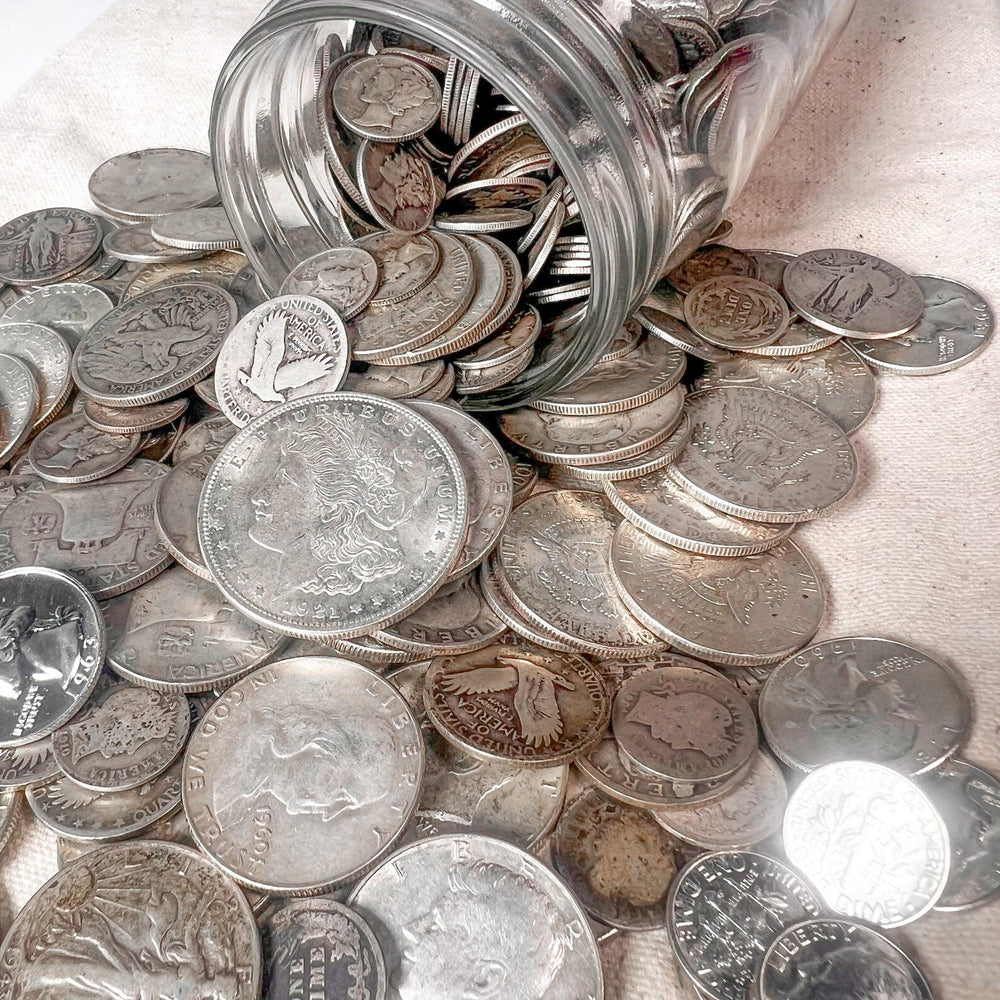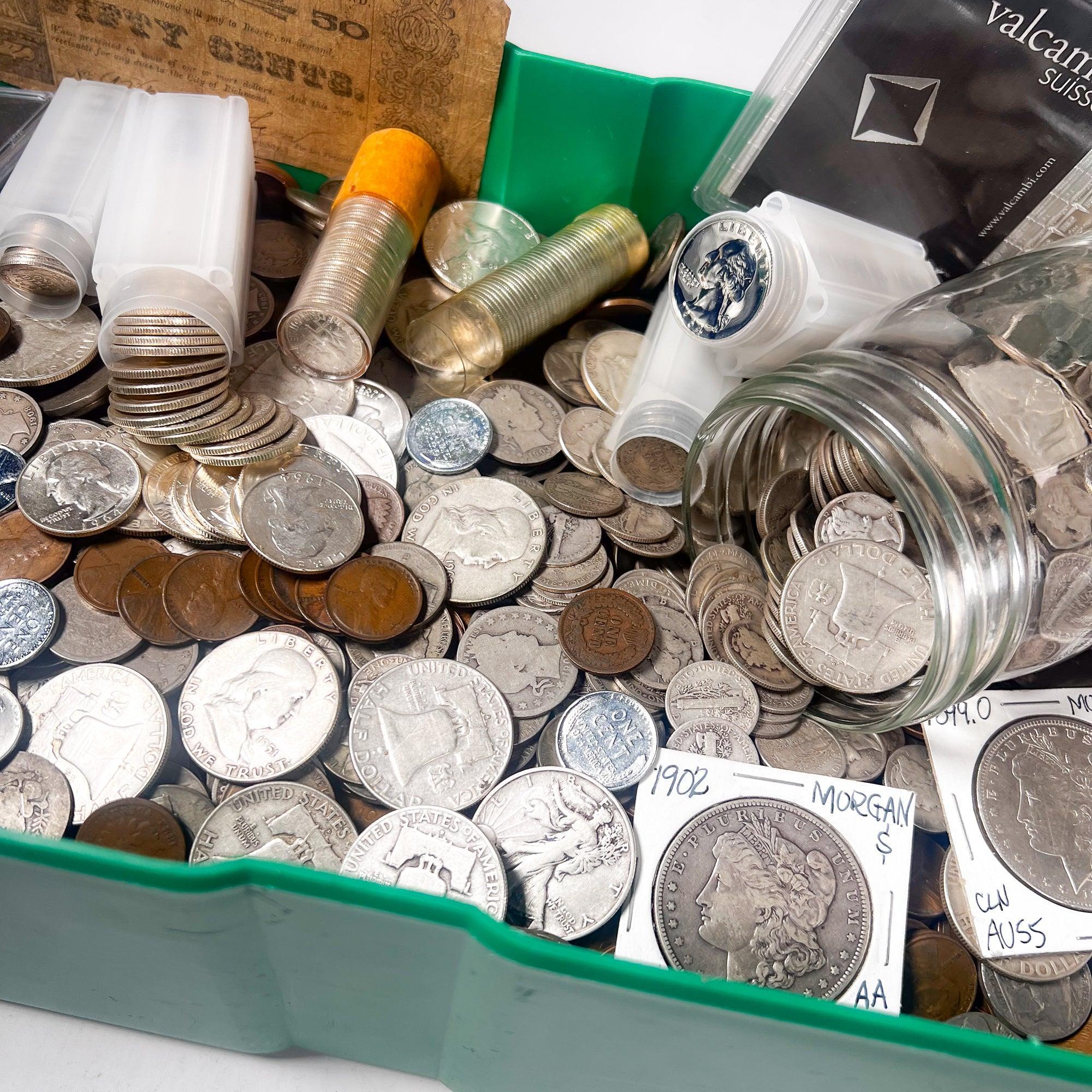A Beginner's Guide to Collecting and Grading Morgan Silver Dollars
Embark on a fascinating journey into American numismatics. Collecting coins, particularly iconic pieces like the Morgan Silver Dollar, offers a unique blend of historical discovery, artistic appreciation, and tangible investment. For many, the world of coin collecting might seem intricate and daunting, filled with specialized jargon and complex valuation methods. This beginner's guide to collecting and grading Morgan Silver Dollars will demystify the initial steps, ensuring you understand everything necessary to start your collection.
This article serves as your clear, accessible entry point into this rewarding hobby. We will explore the enduring appeal of these magnificent coins and discuss various approaches to building your collection. Crucially, we will illuminate the fundamental role of professional grading.
Understanding coin grades isn't just about identifying a coin's condition; it's about protecting your investment, ensuring fair value, and building a truly meaningful collection. Let's begin this exciting adventure together.
Understanding the Morgan Silver Dollar: A Cornerstone of American Numismatics
The Morgan Silver Dollar stands as a towering symbol of American history and remains one of the most beloved and widely collected coins in the world. Its bold design and rich narrative make it a perfect starting point for any aspiring numismatist.
The Enduring Appeal of the Morgan Dollar
From its inception, the Morgan Dollar captivated the American public. Its allure has only grown with time, establishing it as a tangible link to a pivotal era in American history.
The historical significance of the Morgan Dollar is deeply intertwined with the expansion of the American West. Minted during a period of immense growth and industrialization following the Civil War, these coins circulated widely as the nation stretched its boundaries. They witnessed the rise of vast railroad networks, the burgeoning mining industry, and the everyday transactions of pioneers, farmers, and entrepreneurs across a rapidly developing continent. Holding a Morgan Dollar connects you directly to the silver booms of the Comstock Lode and the economic policies that shaped a young nation.
Beyond its historical weight, the artistic design of the Morgan Dollar contributes significantly to its iconic status. Designed by George T. Morgan, an English-born engraver, the coin features a majestic rendition of Lady Liberty on the obverse. She faces left, adorned with a cap inscribed with "LIBERTY," wheat, and cotton in her hair. The reverse showcases a powerful eagle with outstretched wings, clutching an olive branch and arrows, symbolizing peace and preparedness. The intricate details, from the individual strands of Liberty's hair to the feathering on the eagle's wings, showcase a master engraver's skill. This blend of artistry and patriotic symbolism makes it incredibly appealing to collectors.
Perhaps one of its most attractive features is its accessibility for new collectors. Unlike some ultra-rare or highly specialized coins, Morgan Dollars were minted in large quantities. This means plenty of examples are available across a wide range of conditions and price points. This allows beginners to start their journey without immediately breaking the bank, offering a satisfying entry for those wondering how to start collecting Morgan Silver Dollars. You can begin with common dates in circulated condition and gradually work your way up to rarer dates or higher grades as your knowledge and budget grow.
A Brief History of the Morgan Silver Dollar
To truly appreciate the Morgan Dollar, understanding its origins and specifications is helpful. Its creation was the result of specific legislative action, driven by the economic forces of the late 19th century.
The legislation behind its creation was primarily the Bland-Allison Act of 1878. This act mandated the U.S. Treasury to purchase a significant amount of silver each month and coin it into silver dollars. This was largely a response to the lobbying efforts of Western silver mining interests, who sought to increase the demand and price for silver after its demonetization in 1873, known as the "Crime of '73." Though not fully satisfying the silver producers, the act brought the Morgan Dollar into existence, ensuring its prolific mintage for decades.
The key design elements are rich with symbolism. Lady Liberty on the obverse is often said to be modeled after Anna Willess Williams, a Philadelphia schoolteacher, though this is debated among numismatists. Her portrait represents freedom and enlightenment. The reverse eagle, while a common motif on American coinage, is depicted here with a sense of strength and vigilance. Above the eagle, the national motto "In God We Trust" is prominently featured, a practice that became standard on U.S. coinage.
Morgan Dollars were produced at various minting locations, each identified by a distinguishing mint mark on the coin's reverse, below the eagle's tail feathers.
-
Philadelphia (P or no mint mark): Coins minted in Philadelphia typically have no mint mark.
-
San Francisco (S): Known for producing well-struck coins.
-
New Orleans (O): Coins from New Orleans can sometimes exhibit softer strikes.
-
Carson City (CC): Coins from the famed Nevada mint are often highly sought after due to their lower mintages and connection to the silver boom.
-
Denver (D): Only produced Morgan Dollars for one year, 1921.
The composition and specifications of the Morgan Dollar are also important for collectors. Each coin contains 0.77344 troy ounces of pure silver, alloyed with copper for durability. The coin has a standard diameter of 38.1 mm and weighs 26.73 grams. This significant silver content contributed to its substantial feel and inherent value, even beyond its numismatic appeal. Understanding these basics forms a strong foundation for any guide to Morgan Dollar collecting.
Your First Steps: Starting Your Morgan Silver Dollar Collection
Embarking on your Morgan Silver Dollar collecting journey is an exciting prospect. The key to a fulfilling experience is to approach it with a clear strategy and a realistic understanding of what you want to achieve.
Defining Your Collecting Journey
Before you acquire your first coin, consider what kind of collector you want to be. There are many paths you can take, and knowing your preferences early on can help you stay focused and make smart choices.
Different Approaches to Collecting Morgan Dollars
Your collection can be shaped by various goals, each offering unique rewards.
Collecting by Date and Mint Mark is a very popular approach. Many collectors strive to build a complete set of Morgan Dollars, acquiring one coin from each year and minting location. This can be a challenging but incredibly rewarding endeavor, especially as you pursue key dates (those with lower mintages, making them rarer) and semi-key dates. For example, the 1893-S is a renowned key date, notoriously difficult and expensive to acquire in any condition. Others might focus on collecting only coins from a specific mint, like Carson City, which offers a concentrated pursuit. The thrill of the hunt for that elusive date or mint mark can be a significant motivator, making each acquisition a small victory.
Alternatively, you might choose Collecting by Condition or Grade. This approach focuses less on completing sets and more on the quality of individual coins. Some collectors might specialize in acquiring beautiful circulated examples, appreciating the history etched onto each worn surface. They might target coins in Very Fine (VF) or Extremely Fine (XF) condition, which are more affordable but still attractive. On the other hand, many advanced collectors aim for high-grade uncirculated coins, often referred to as Mint State (MS) examples.
These coins show no signs of wear and retain their original mint luster. Pursuing high-grade coins can be more expensive, but the visual appeal and long-term value potential are often higher. Ultimately, your personal preference will guide your choices, and there is no single "right" way to collect.
As an experienced collector, my own journey into coin collecting for beginners started with a simple fascination for old coins. Holding a worn Morgan Dollar evoked stories of the "Wild West" and the silver mines, sparking an undeniable curiosity. My first Morgan Dollar was a well-circulated 1900-O, acquired not for its grade or rarity, but because it simply felt old and real. This entry point, fueled by curiosity, taught me the importance of starting with what genuinely excites you, regardless of market trends.
Before diving in, setting a realistic budget and expectations is crucial. Morgan Dollars range from around $30-$40 for common dates in low circulated grades to hundreds of thousands of dollars for pristine key dates. Understand what you can comfortably spend and what your long-term goals are. Are you looking for a few interesting historical pieces, or are you aiming to build a valuable collection over decades? Clarity on these points will make your journey more enjoyable and sustainable.
Where to Begin Your Search for Authentic Coins
Once you have a sense of your collecting direction, the next vital step is knowing where to find authentic Morgan Dollars. The numismatic market, while generally transparent, does have its pitfalls, and avoiding fakes is paramount.
One of the safest and most reliable places to begin your search is with reputable coin dealers, both online and brick-and-mortar stores. Established dealers have a reputation to uphold and typically offer a wide selection of authenticated coins. They can provide expert advice, help you understand various grades, and even offer guarantees on authenticity. Building a relationship with a trusted local dealer can be invaluable, as they can often source specific coins for you and guide your collecting journey. When dealing online, look for dealers with strong positive reviews, transparent return policies, and clear high-resolution images of their inventory.
Attending local and national coin shows and conventions also provides an excellent opportunity to find coins and connect with the numismatic community. At these events, you will find numerous dealers under one roof, allowing you to compare prices, inspect coins in person, and learn directly from experts. Coin shows are vibrant hubs of activity, perfect for immersing yourself in the hobby and gaining firsthand experience with different coins. Many shows also offer educational seminars, which are great for understanding coin grades.
Navigating online marketplaces and auction sites requires significantly more caution. While these platforms can offer a vast selection and competitive prices, they also come with a higher risk of encountering counterfeit coins or misrepresented items. If you choose to buy from sites like eBay, always prioritize sellers with high ratings, extensive sales history, and a focus on professionally graded coins. Be wary of deals that seem "too good to be true," as they often are.
The paramount importance of purchasing authenticated coins from trusted sources to avoid fakes cannot be overstated. Counterfeiting is a persistent issue in the coin market, and even experienced collectors can be fooled by sophisticated fakes. This is where the concept of third-party grading becomes absolutely essential, which we will discuss in detail shortly. Always insist on purchasing coins that have clear provenance or have been authenticated and graded by a professional service. This is the surest way to protect your investment and ensure you are adding genuine pieces of history to your collection.
The Cornerstone of Collecting: Understanding Coin Grades
If you take only one concept away from this guide, let it be this: understanding coin grades is the single most critical skill in numismatics. It is the bedrock upon which all sound collecting decisions are built, especially when it comes to assessing the value and authenticity of your Morgan Dollars. This is the heart of effective Morgan Dollar collecting.
Why Coin Grading is Essential for Morgan Dollars
The precise condition of a coin, known as its "grade," directly correlates with its value. Two Morgan Dollars from the same year and mint mark can have vastly different values based solely on their grade. A common date Morgan Dollar in a low circulated grade might be worth just its silver melt value, while the same date in pristine, uncirculated condition could be worth thousands. Without a consistent and objective grading system, fair pricing would be impossible, leading to chaos and distrust in the market.
Professional grading ensures consistency and fair pricing in the numismatic market. It provides a universal language that allows collectors, dealers, and auction houses to communicate about a coin's condition without ambiguity. When you buy a coin graded MS-65, you can be confident that its condition meets a specific, recognized standard, regardless of who is selling it or where. This standardization builds trust and liquidity, making it easier for collectors to buy, sell, and trade with confidence.
Ultimately, understanding and utilizing professional grading is about protecting your investment and building a valuable collection. Imagine spending a significant sum on a coin you believe to be high-grade, only to find out later it is a lower-grade example or, worse, a fake. Professional grading mitigates these risks by providing an objective assessment of authenticity and condition from unbiased experts. It transforms collecting from a speculative gamble into a more secure and informed pursuit, safeguarding the value of your assets.
Basic Coin Grading Terminology for Beginners
Coin grading, at first glance, might seem like a complex labyrinth of acronyms and numbers. However, the core principles are quite straightforward, built around a universal language that every serious collector eventually learns.
The Sheldon Scale: A Universal Language
The most widely accepted standard for grading coins today is the Sheldon Scale, a 70-point numerical grading scale. Developed by Dr. William Sheldon in the 1940s, it originally applied to large cents but was later adapted for all U.S. coins. This scale ranges from 1 (Poor, indicating barely identifiable features) to 70 (Perfect Mint State, a flawless coin).
On this scale, coins are broadly categorized into two main groups, distinguishing between Circulated (PO-AU) and Uncirculated (MS) coins.
-
Circulated Grades (PO-AU): These coins have been in commerce and show varying degrees of wear.
-
PO (Poor): Barely recognizable, heavy wear.
-
FR (Fair): Some design elements visible, but major wear.
-
AG (About Good): Most of the design is outlined, but details are flat.
-
G (Good): Design is bold, but heavily worn.
-
VG (Very Good): Design clear but lacks sharpness.
-
F (Fine): Significant wear, but major details are visible.
-
VF (Very Fine): Moderate wear on high points, all major details sharp.
-
XF (Extremely Fine): Light wear on high points, excellent detail.
-
AU (About Uncirculated): Traces of wear on highest points, some luster may remain.
-
Uncirculated Grades (MS-60 to MS-70): These coins have never been in circulation and retain their original mint luster.
-
MS (Mint State): Ranging from MS-60 to MS-70, these coins show no signs of wear. The number indicates the coin's overall attractiveness, strike, and freedom from post-minting marks. An MS-70 is a flawless coin, theoretically perfect, though exceedingly rare for Morgan Dollars.
When assessing a coin's grade, professional graders look at several key elements. These include the degree of wear on the coin's highest points where wear first occurs, the amount of original luster remaining, the sharpness of the strike (how well the design elements were pressed into the coin), the color and consistency of toning (the natural patina that develops on silver over time), and the overall surface preservation. They also note any detracting marks like scratches, nicks, or environmental damage. For example, a coin with a strong strike will have sharply defined details, while a weak strike will appear mushy.
Common Morgan Dollar Grades You Will Encounter
As you begin your guide to Morgan Dollar collecting, you will quickly become familiar with the various grades. Each range tells a story of the coin's journey since leaving the mint.
Coins in the Good (G) through Very Fine (VF) range are classic examples of circulated coins. These coins often represent the most affordable entry points into collecting Morgan Dollars. A coin graded Good (G-4) will show heavy wear, with many details flat or merged, but the date and mint mark will still be discernible. As you move up to Very Good (VG-8), more of the design will be clear, but still well-worn. Fine (F-12) will show distinct design elements with noticeable wear on all high points. Very Fine (VF-20 or VF-30) coins will have significant detail, with only the highest points showing signs of flattening. These grades are perfect for collectors who appreciate the historical feel of a coin that has "been there and done that."
Extremely Fine (XF) and About Uncirculated (AU) are considered transitional grades. An Extremely Fine (XF-40 or XF-45) Morgan Dollar will have only slight wear on the highest points of the design, with nearly all details sharp and some original mint luster potentially remaining in protected areas. About Uncirculated (AU-50, AU-55, AU-58) coins are tantalizingly close to uncirculated status.
They show only the barest traces of friction or wear on the absolute highest points, often visible only under magnification, and retain much of their original luster. An AU-58 is often referred to as a "slider" because it is just one step below Mint State, having perhaps only a single whisper of friction. These grades offer a significant jump in visual appeal and value compared to lower circulated coins.
Finally, Mint State (MS-60 to MS-70) represents the pinnacle of preservation for understanding coin grades. These coins show no signs of circulation wear whatsoever.
-
MS-60 to MS-62 (Uncirculated or "Basal Unc"): These coins are technically uncirculated but may have significant bag marks, scratches, or a dull luster from handling at the mint or in bags.
-
MS-63 (Choice Uncirculated): A solid uncirculated coin, with fewer distractions than an MS-60/62, good luster, and an appealing appearance.
-
MS-64 (Choice Uncirculated): A very attractive coin with a strong strike and good luster, though it may have a few minor bag marks or other distractions.
-
MS-65 (Gem Uncirculated): A highly desirable grade, these coins are considered "Gem" quality. They possess strong luster, a sharp strike, and minimal distracting marks. This is a common target for collectors seeking beautiful coins.
-
MS-66 to MS-70 (Superb Gem to Perfect Uncirculated): These are exceptional coins, virtually flawless or perfect under magnification. Obtaining Morgan Dollars in these upper Mint State grades is extremely challenging and expensive due to their rarity and demand.
For a beginner, focusing on the practical application of these grades is key. Do not worry about microscopic details right away. Instead, train your eye by comparing coins of different grades. The more coins you observe, the better you will become at distinguishing between them. We will not delve into the complex world of VAM varieties (variations in dies used to strike the coins) in detail here, as that is a more advanced topic for when you have mastered the basics. For now, focus on the overall condition and how it relates to the numerical grade.
Professional Coin Grading Services (PCGS & NGC): Your Assurance of Authenticity and Value
While learning to grade coins yourself is an essential part of becoming a knowledgeable collector, there comes a point, especially with higher-value coins, where objective, third-party authentication and numismatic grading become indispensable. This is where professional coin grading services enter the picture, acting as the ultimate safeguard for your collection.
The Indispensable Role of Third-Party Graders (TPGs)
In the modern numismatic market, Third-Party Graders (TPGs) like PCGS (Professional Coin Grading Service) and NGC (Numismatic Guaranty Company) play an absolutely vital role. Their primary function is establishing authenticity and combating counterfeits. With increasingly sophisticated fakes entering the market, it is incredibly difficult for even experienced collectors to spot every phony. TPGs employ teams of expert authenticators who use advanced techniques and extensive experience to verify a coin's legitimacy, protecting collectors from fraudulent purchases.
Beyond authentication, TPGs provide an objective, standardized, and unbiased grade for each coin. They remove the subjectivity that can arise when a buyer or seller tries to grade a coin themselves. TPGs adhere to strict, consistent grading standards, ensuring that an MS-65 graded by PCGS in 2025 will be equivalent to an MS-65 graded by NGC in 2015. This standardization fosters trust and transparency across the entire market, providing a level playing field for everyone.
Once a coin is authenticated and graded, it is encapsulated in a tamper-evident, sonically sealed, clear plastic holder, often referred to as a "slab." This secure encapsulation serves two crucial purposes: long-term protection and easy identification. The inert plastic protects the coin from environmental damage, handling marks, and harmful substances, preserving its condition for generations. Furthermore, the slab includes a label with all the coin's key information, including its type, date, mint mark, numerical grade, and a unique certification number, making it easy to identify and verify. This certified "slab" becomes the coin's permanent, secure home, providing peace of mind and significantly increasing its liquidity in the market.
Decoding PCGS and NGC Labels
Understanding the information presented on a PCGS or NGC slab is simple once you know what to look for. These labels are designed to convey all the critical details about your coin at a glance, further demystifying numismatic grading.
Understanding the Slab and Label Information
When you look at a professionally graded Morgan Dollar in its slab, the label holds a wealth of information.
-
Coin Type and Date/Mint Mark: This is usually the largest text, clearly stating "Morgan Dollar," followed by the year of mintage and its mint mark (e.g., "1896-O" or "1921-S").
-
The Numerical Grade: This is the most prominent detail, typically a two-digit number preceded by "MS" for Mint State (e.g., MS-64) or the appropriate circulated grade (e.g., AU-58, VF-20). This numerical grade is the core of the coin's certified condition.
-
Variety Attributions: You might occasionally see variety attributions on a label, such as "VAM-1A" or "Hot Lips." These indicate specific, recognized die varieties that can add to a coin's appeal and value. PCGS and NGC often include these if they are well-known and significant, but for your initial focus, the main grade is paramount.
Beyond the basic numerical grade, you will sometimes see specific designations on the label. The significance of Plus (+) grades means the coin is strong for its assigned grade, almost but not quite warranting the next full numerical step (e.g., MS-64+). Designations like "PL" (Prooflike) or "DMPL" (Deep Mirror Prooflike) indicate that the coin has highly reflective, mirror-like fields, similar to those found on proof coins, even though they were struck for circulation. "DMPL" is rarer and indicates even deeper mirror qualities. These designations can significantly enhance a Morgan Dollar's value and visual appeal.
Furthermore, you may encounter the role of Certification Verification Services like CAC (Certified Acceptance Corporation). CAC places a small green bean sticker on PCGS and NGC graded coins that, in their expert opinion, represent strong examples for their assigned grade, often bordering on the next higher grade. A gold CAC sticker means the coin would actually grade higher than its assigned grade. While not a grading service itself, CAC adds another layer of confidence for collectors seeking premium quality within a given grade.
When to Consider Professional Grading for Your Morgan Dollars
Deciding when to send a coin for professional grading is an important part of maximizing your collection's value and liquidity. It is not necessary for every coin, but it becomes critical in certain situations.
You should definitely consider professional grading for higher-value or potentially higher-grade coins. If you acquire a Morgan Dollar that appears to be in Uncirculated condition (MS-60 or higher) or is a known key date, sending it to a TPG is a wise investment. The cost of grading will likely be offset by the increased value and marketability of a certified coin. Without a professional grade, estimating its true value, especially for a rarer piece, becomes largely speculative.
For coins intended for long-term collection, investment, or future resale, professional grading is virtually a requirement. A slabbed coin is much easier to sell or trade because its authenticity and condition are independently verified. This eliminates buyer uncertainty and streamlines transactions. Think of it as a certificate of authenticity and quality assurance that dramatically boosts buyer confidence.
Ultimately, using a professional coin grading service offers immense peace of mind and increased liquidity in the market. You will rest assured that your coin is genuine and accurately graded, eliminating any lingering doubts. Should you ever decide to sell or upgrade parts of your collection, a professionally graded Morgan Dollar will command higher prices and attract more serious buyers, making the entire process smoother and more profitable. It is an investment in the security and value of your collection.
Essential Tools and Resources for the Aspiring Morgan Dollar Collector
As you delve deeper into collecting Morgan Dollars, a few essential tools and resources will prove invaluable. These are not just accessories; they are vital companions on your numismatic journey, helping you to handle, store, identify, and research your coins properly.
Basic Supplies for Handling and Storage
Proper handling and storage are crucial to preserving your Morgan Dollars' condition and value. Remember, a coin's grade can be negatively impacted by improper care, so invest in the right supplies from the outset.
The first line of defense for your collection is appropriate storage. Coin albums, binders, and archival-safe holders are paramount. For individual coins, prioritize Mylar flips or non-PVC plastic sleeves. Avoid older PVC (polyvinyl chloride) flips, as they can leach chemicals over time that damage coins, causing a green, sticky residue. For more valuable coins, or once they are professionally graded, their certified slabs are the ideal long-term storage solution. These are designed to be chemically inert and offer robust physical protection. Using dedicated coin albums and coin holders specifically designed for numismatic preservation will safeguard your coins from environmental harm and physical damage.
When handling your coins, especially those in higher grades, always use cotton gloves. The oils and acids from your fingertips, even if you think your hands are clean, can leave permanent marks or accelerate toning on a coin's surface. Cotton gloves provide a protective barrier, allowing you to examine your coins without leaving harmful residues.
A jeweler's loupe or magnifying glass is an indispensable tool for detailed inspection. While you will not be professionally grading coins with it, a 5x to 10x magnification will allow you to examine fine details, detect minute wear, observe luster, and even spot small errors or varieties that might not be visible to the naked eye. This helps you better appreciate the artistry and condition of your coins.
Finally, while you might acquire soft cleaning cloths, it is crucial to emphasize the golden rule of coin collecting: never clean your coins. Cleaning, even with a soft cloth, can permanently damage a coin's surface, disrupt its original patina (toning), and drastically reduce its numismatic value. What might seem like "dirt" or "tarnish" to a beginner is often a natural and desirable part of a coin's history and character to an experienced collector. A cleaned coin is almost always worth significantly less than an uncleaned one, even if it appears "shinier." Leave any cleaning or conservation to experienced professionals, but for the vast majority of collectors, the best approach is simply to leave coins as found.
Indispensable Reference Materials and Learning Tools
Beyond physical supplies, a well-stocked numismatic library and access to online resources are vital for growing your knowledge and making informed decisions.
Reputable Coin Guides and Price Catalogs
One of the most fundamental resources for any U.S. coin collector is "The Red Book," officially titled A Guide Book of United States Coins. This annual publication is an encyclopedic resource covering virtually every U.S. coin ever minted, including Morgan Dollars. It provides historical context, mintage figures, detailed descriptions, and, most importantly for beginners, estimated retail values across various grades. While values in any printed guide are a snapshot in time and can fluctuate, the Red Book provides an excellent baseline for understanding rarity and relative values. My strong advice for coin collecting for beginners is to acquire a current edition of the Red Book early on; it is an investment in your education.
In addition to physical books, online databases from grading services like PCGS and NGC are invaluable. Their websites offer comprehensive population reports (showing how many coins of a specific date, mint mark, and grade have been certified), price guides based on actual auction results, and high-resolution images. These resources allow you to research specific coins, track market trends, and compare different examples. Numismatic organizations like the American Numismatic Association (ANA) also offer a wealth of educational materials and online resources.
For more advanced insights into market analysis and pricing trends, subscription services from independent pricing guides or major auction houses can provide up-to-the-minute data. These are often geared towards more experienced collectors or dealers, but being aware of their existence is a good step as you progress. They can help you understand subtle shifts in demand and value that are not apparent from basic price guides.
Connecting with the Numismatic Community
Coin collecting does not have to be a solitary pursuit. Connecting with other collectors can significantly enhance your enjoyment and accelerate your learning.
The benefits of joining local coin clubs or national numismatic associations are immense. Local clubs offer regular meetings where you can meet fellow collectors, share knowledge, attend educational presentations, and sometimes even participate in club-only auctions. National organizations like the American Numismatic Association (ANA) offer a wider range of resources, including educational seminars, publications, and access to a vast network of experts. These communities provide mentorship, camaraderie, and opportunities to see and learn about a wider variety of coins.
Participating in online forums and communities is another fantastic way to get advice and share knowledge. Websites like CoinTalk or specific numismatic subreddits are bustling with collectors eager to discuss coins, offer opinions on potential purchases, and share their latest finds. This provides a 24/7 source of information and support, allowing you to ask questions, learn from others' experiences, and stay updated on market news from the comfort of your home. It is a great way to deepen your guide to Morgan Dollar collecting knowledge.
Protecting Your Investment and Continuing Your Numismatic Journey
As your Morgan Dollar collection grows, so too does its value, both monetary and sentimental. Protecting your investment through proper care and safeguarding practices becomes increasingly important, ensuring that your passion remains a rewarding endeavor for years to come.
Proper Care and Preservation of Your Morgan Dollar Collection
The ongoing care of your coins is just as important as how you acquire them. A well-preserved collection will retain its value and beauty far longer than one subjected to neglect or improper conditions.
Environmental Control and Storage Best Practices
The environment in which your coins are stored has a profound impact on their long-term preservation. You must strive for optimal environmental control and storage best practices. This means avoiding extreme temperatures, high humidity, and direct sunlight. Fluctuations in temperature can cause coins to expand and contract, potentially damaging holders or causing surface issues. High humidity, especially combined with pollutants in the air, can accelerate toning or even lead to corrosion on silver coins. Direct sunlight can also cause uneven toning or even heat damage to coins over extended periods. A stable, cool, dry environment is ideal.
Always use inert, archival-safe storage materials. As discussed earlier, avoid any storage materials that contain PVC. Stick to Mylar flips, non-PVC plastic holders, or certified slabs from PCGS or NGC. Store albums or slab boxes in a cool, dark place, away from external walls where temperature and humidity fluctuations are more pronounced. Consider using silica gel packets in sealed containers if you live in a particularly humid climate, but be sure to replace them periodically.
And once more, I must emphasize the golden rule: Never clean your coins. This cannot be stressed enough. It is the single most common and detrimental mistake new collectors make. A coin's original surface, including its natural toning or patina, is integral to its numismatic value. Cleaning, whether by rubbing, using chemical dips, or even soap and water, will irrevocably damage the surface, leaving behind telltale hairlines, an unnatural sheen, or dullness. Such damage is permanent and will significantly decrease the coin's value, often by 50% or more, even for common dates. Embrace the coin's natural state; its journey is part of its charm.
Safeguarding Your Assets
For more valuable collections, thinking about broader safeguarding measures is a logical next step.
Creating a detailed inventory of your collection is a crucial administrative step. This inventory should include
-
Date and mint mark of each coin.
-
Its grade (especially if professionally certified).
-
Purchase date and price.
-
Seller information.
-
Any unique identifiers, like a certification number.
-
High-resolution photos of each side of the coin. This inventory serves multiple purposes: it helps you track your collection's growth, provides documentation for insurance purposes, and acts as a record in case of theft or disaster.
For significant collections, considering insurance is a wise decision. Standard homeowner's insurance policies often have limited coverage for collectibles. Speak with your insurance provider about extending coverage for your numismatic assets, or consider a specialized fine art or collectibles insurance policy. This protection can provide financial peace of mind against unforeseen events like theft, fire, or natural disasters.
Beyond the Basics: Growing Your Expertise and Enjoyment
Your journey into Morgan Dollar collecting truly is a lifelong pursuit of learning and enjoyment.
As you gain confidence with grading basics and collection management, you might want to consider delving deeper into specific varieties and mint errors. While we intentionally avoided detailed discussions of VAMs in this guide to keep it beginner-friendly, VAM (Van Allen-Mallis) varieties are a popular area of specialization for Morgan Dollar collectors. These are specific, identifiable differences in the dies used to strike the coins, ranging from prominent repunched dates to subtle die breaks or clashes. Discovering a rare VAM on a coin you already own can be incredibly exciting. This is a natural next step for those who enjoy meticulous research and detailed observation.
Attending advanced numismatic seminars and workshops, often offered at major coin shows or by national organizations, can further grow your expertise. These educational opportunities provide in-depth knowledge on specific series, grading nuances, conservation, and market trends, allowing you to connect with leading experts in the field.
Ultimately, the long-term joy and historical connection of being a guide to Morgan Dollar collecting enthusiast lie in continuous discovery. Each coin has a story, and each step you take in building your collection deepens your appreciation for history, art, and the intricate world of numismatics. This hobby is not just about acquiring valuable objects; it is about connecting with the past, engaging your mind, and finding profound satisfaction in a pursuit that can last a lifetime.
Collecting Morgan Silver Dollars is an incredibly rewarding journey, rich with history, beauty, and opportunity. Remember, starting effectively begins with understanding basic collecting principles, knowing how to find authentic coins, and critically recognizing the paramount importance of professional grading for long-term value. These foundations will empower you to make informed decisions, protect your investment, and truly enjoy every step of your numismatic adventure. This Beginner's Guide to Collecting and Grading Morgan Silver Dollars has provided a solid starting point.
As you begin or expand your collection, consider exploring reputable sources for authenticated coins. Midwest Precious Metals Exchange offers a variety of authenticated Morgan Silver Dollars, including starter sets and professionally graded entry-level coins, providing a reliable pathway for new collectors to acquire quality pieces with confidence. Take that first step, embrace the learning process, and soon you will be holding a piece of American history that tells its own unique story. Happy collecting!












